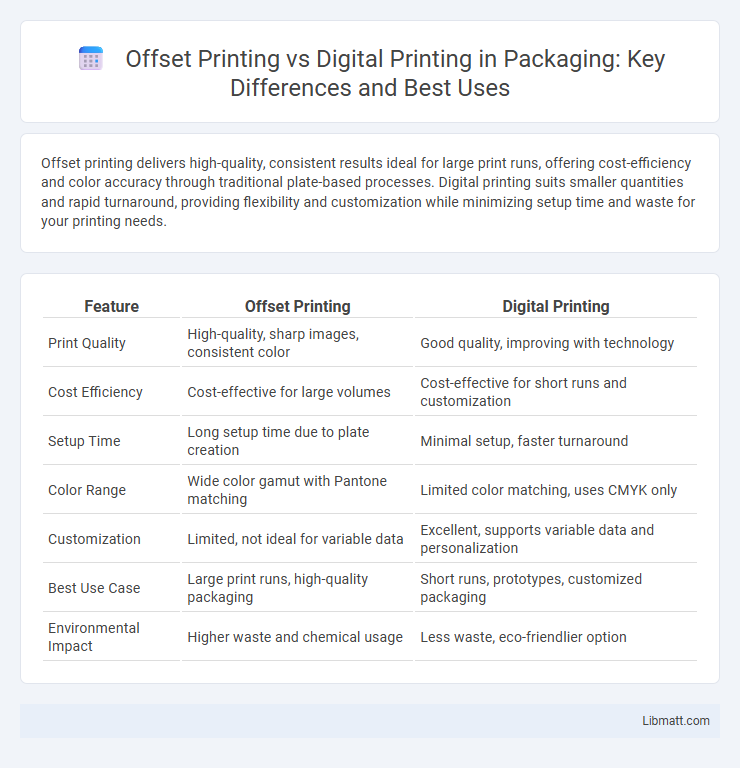Offset printing delivers high-quality, consistent results ideal for large print runs, offering cost-efficiency and color accuracy through traditional plate-based processes. Digital printing suits smaller quantities and rapid turnaround, providing flexibility and customization while minimizing setup time and waste for your printing needs.
Table of Comparison
| Feature | Offset Printing | Digital Printing |
|---|---|---|
| Print Quality | High-quality, sharp images, consistent color | Good quality, improving with technology |
| Cost Efficiency | Cost-effective for large volumes | Cost-effective for short runs and customization |
| Setup Time | Long setup time due to plate creation | Minimal setup, faster turnaround |
| Color Range | Wide color gamut with Pantone matching | Limited color matching, uses CMYK only |
| Customization | Limited, not ideal for variable data | Excellent, supports variable data and personalization |
| Best Use Case | Large print runs, high-quality packaging | Short runs, prototypes, customized packaging |
| Environmental Impact | Higher waste and chemical usage | Less waste, eco-friendlier option |
Introduction to Printing Methods
Offset printing uses plates to transfer ink onto paper, making it ideal for high-volume, consistent-quality jobs with lower per-unit costs. Digital printing directly prints digital images onto various substrates, offering faster turnaround and better customization for small to medium print runs. Your choice depends on factors like quantity, budget, and the need for personalization.
What is Offset Printing?
Offset printing is a traditional printing technique where ink is transferred from a metal plate to a rubber blanket, then onto the printing surface, producing high-quality, consistent images suitable for large-volume runs. It excels in cost-efficiency and color accuracy when printing bulk materials like brochures, magazines, and newspapers. If your project demands sharp details and vibrant colors with substantial quantity, offset printing offers optimal results compared to digital printing.
What is Digital Printing?
Digital printing is a modern printing technique that transfers digital images directly onto various substrates without using traditional plates or screens. It offers faster turnaround times, cost-effectiveness for short runs, and high-quality output with precise color accuracy. Your choice of digital printing allows for easy customization and on-demand production, making it ideal for personalized marketing materials or small-batch projects.
Key Differences Between Offset and Digital Printing
Offset printing offers high-quality output with consistent color accuracy and is ideal for large print runs due to its cost-efficiency at scale. Digital printing provides faster turnaround times and greater flexibility, making it suitable for short runs and customization with variable data. Your choice depends on factors like print volume, budget, and the need for color precision or personalization.
Print Quality Comparison
Offset printing delivers superior print quality with sharp, precise details, consistent color fidelity, and smooth gradients due to its use of metal plates and oil-based inks. Digital printing offers good quality for shorter runs, utilizing toner or inkjet technology, but may exhibit slight variations in color accuracy and image crispness compared to offset. For high-volume projects requiring exact color matching and fine detail, offset printing remains the preferred choice.
Speed and Turnaround Times
Offset printing typically offers faster turnaround times for large print runs due to its high-speed production capabilities and efficient setup for bulk orders. Digital printing excels in speed for small to medium quantities, enabling quicker turnaround without the need for extensive setup or plate creation. Your project's size directly influences whether offset's rapid output or digital's immediate-print advantage delivers faster results.
Cost Efficiency and Budget Considerations
Offset printing offers superior cost efficiency for high-volume projects due to lower per-unit costs once setup expenses are covered, making it ideal for large print runs with consistent quality. Digital printing minimizes upfront costs and is more budget-friendly for small batches or variable data printing, eliminating the need for plates and lengthy setup times. Businesses must assess print volume and project timeline to choose between offset's scalability and digital's flexibility for optimal budget management.
Customization and Flexibility
Offset printing excels in high-volume runs with consistent image quality, but offers limited customization and slower turnaround times due to setup requirements. Digital printing provides superior flexibility, enabling easy customization for variable data printing and quick adjustments without setup delays. For projects demanding rapid changes and personalized content, digital printing is the preferred choice, while offset printing suits standardized, large-volume jobs.
Ideal Applications for Each Printing Method
Offset printing excels in high-volume projects like magazines, brochures, and large-scale marketing materials, offering superior color accuracy and cost efficiency for bulk runs. Digital printing suits short runs, customization, and quick turnaround needs, ideal for personalized invitations, business cards, and prototype proofs. Your choice depends on project size, budget, and required print quality.
Choosing the Right Printing Method for Your Needs
Offset printing delivers superior image quality and cost-efficiency for large-volume projects, making it ideal for bulk brochures, magazines, and catalogs. Digital printing offers faster turnaround and customization options, perfect for short runs, personalized marketing materials, and prototypes. Evaluating factors such as quantity, budget, design complexity, and delivery time guides the choice between offset and digital printing methods.
Offset printing vs digital printing Infographic

 libmatt.com
libmatt.com